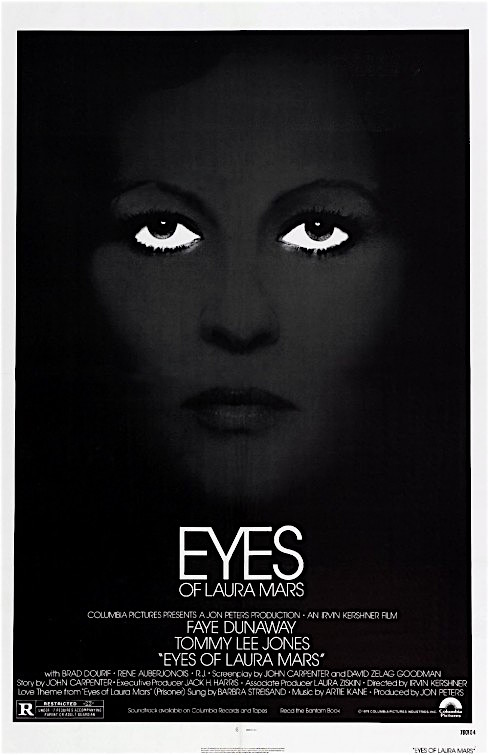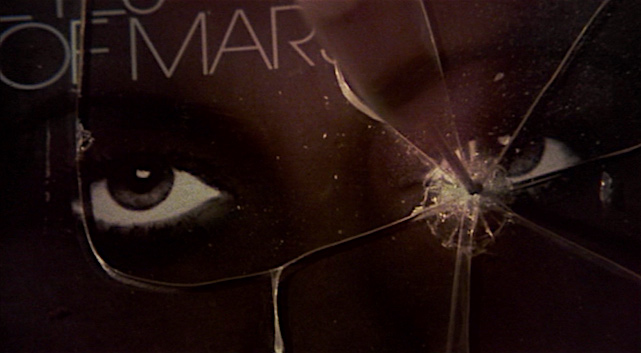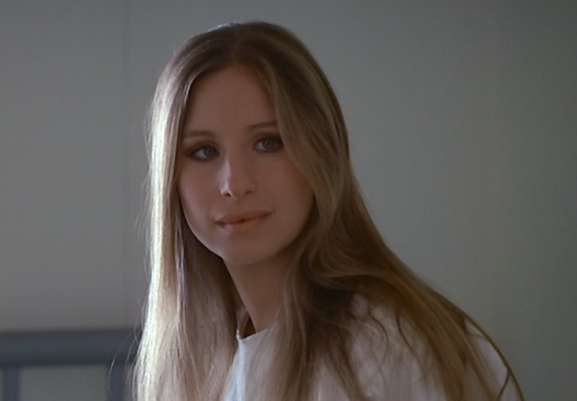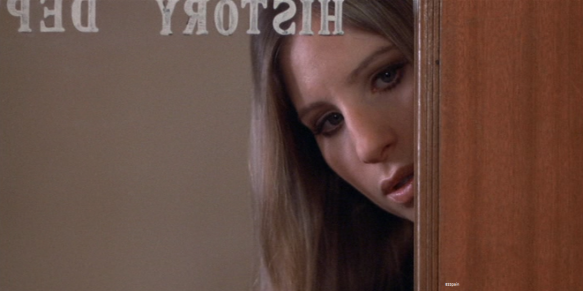One can’t help but wonder what might have happened if John Carpenter had filmed his own script of Eyes of Laura Mars. It is a rather silly question as he did not film his own script. Instead that duty was assigned to the skilled filmmaker, Irvin Kershner. The only director bold enough to stand his ground against the likes of George Lucas while shooting his film for the Star Wars franchise and the director who was able to assist Barbra Streisand tone it all down to play a very believable housewife in a very surreal experimental film of the early 1970’s, Up The Sandbox.

“And your eyes say everything. You wanna keep me here forever
I can’t escape. One minute’s so sincere.
Then you completely turn against me. And I’m afraid…”
An Iconic Movie Poster
Eyes of Laura Mars
Irvin Kershner, 1978
Up until 1977 he had never directed a horror film. It is clear that the under-appreciated film artist was less interested in the terror aspects of Carpenter’s script than in using it to focus on the problematic trend of mixing sex with violence as a form of subversion or perverse eroticism. One merely has to glance at only one of Rebecca Blake’s photographs taken for the film to understand that she is carefully constructing slick photographs in the vein of Helmut Newton or Guy Bourdin. Interestingly, these provocative and aggressively misogynistic photographs point toward where Karl Lagerfeld would be headed later on.

Is Laura Mars really only selling shampoo here?
Eyes of Laura Mars
Irvin Kershner, 1978
Photograph | Rebecca Blake
John Carpenter’s original screenplay is fairly simple: A Post-Feminist (???) fashion photographer takes controversial photographs which capture not only the erotic elements of the female form in stylish clothing, but acts of brutal violence and murder. Violence and murder usually aimed at women. Her work is highly profitable and has made her a bit of a celebrity. As a coffee table book collecting some of her most infamous photographs hits the stores, people close to her begin to be murdered in horrible ways that always culminate with their eyes being gouged out.
Even more disturbing, the photographer begins to lose her own vision only to be replaced with the POV of the killer for the duration of each murder. Amping up the horror is the fact that the pop culture princess of fashion photography discovers that all of her photographs mimic a number of brutal and confidential police shots of actual murders. Hence, it would appear that Ms. Mars is somehow psychically linked to a serial killer. It is the psychotic madness of a killer who has been inspiring her art. Art that many are eager to purchase and admire.
Eventually, the killer sets his sites on Laura Mars herself. As the killer tries to kill her she is put in the chilling position of POV limitation — she can only see herself as the killer goes after her. Essentially blind with only disorienting and panicked visions of her own body as target, she is a prisoner of the killer’s eyes ...and her own.
John Carpenter deserves a great deal of credit with coming up with an original and scary concept. It is unlikely he viewed as any sort of cultural or pop art commentary, but the circumstance of the imagined situation opens that door. Enter the decision to hire Irvin Kershner as the director. By securing the respected film director, the already infamous producer of the project was able to seal a deal with Faye Dunaway to play the lead character. In 1977, this was a casting coup. Dunaway was at the height of her cinematic power in the mid to late 1970’s. A beautiful and respected Academy Award winning actress, Ms. Dunaway was sought after.
Initially Jon Peters was rumored to have wanted to talk his then Life Partner, Barbra Streisand, into taking the role. The script was too violent and dark for Streisand’s taste. She did agree to sing a theme song which turned out to be a surprisingly rock-driven song. The esteemed Conrad Hall was rumored to be first choice to serve as the film’s cinematographer, but Kershner wanted Victor J. Kemper. He got him.
Several gorgeous models were hired to serve as models and actors. Tommy Lee Jones was secured for the leading male love interest. And thanks to a large paycheck, several respected actors were cast in supporting roles — most notably Brad Dourif and Raul Julia. This was an A List Production out of the gate.

Armed and ready to take aim at herself. So to speak.
Faye Dunaway
Eyes of Laura Mars
Irvin Kershner, 1978
Cinematography | Victor J. Kemper
When the results of the finished film screened in 1978, viewers were presented with a cinematic cornucopia of ideas and images. Some of these worked. Others failed. Mixed together — Eyes of Laura Mars became a largely mixed experience for film critics and an often vexing one for the audience. The film was a hit. Though filled with tension, the movie failed to actually be scary.
While Laura Mars‘ photographs are violently and sexually graphic, the film is surprisingly restrained. Most certainly the violence and amount of nudity earned the film an R rating, but there was a loopy sort of immature logic holding the film together.
Some did find the movie disturbing. Some found it to be a fun ride with more than a few unexpected twists. Others were just left a bit confused.

A male’s smackdown on a beautiful woman is intended to sell cologne.
Eyes of Laura Mars
Irvin Kershner, 1978
Photograph by Rebecca Blake
37 years later Eyes of Laura Mars continues to entertain. Sadly, much of the entertainment grows out of unintentional camp.
This is not to say that this odd bit of big-budget 1970’s filmmaking does not hold some merit. But the film’s merits are easily over-powered by the strange plot, Dunaways’s soap-opera like turn and some deeply campy “stupid model” moments. The movie is a fun, pretty and ungrounded mess. And over the past decade it has developed a sizable cult following.
Most view Eyes one of those “So Bad It’s Great” cinematic guilty pleasures. While I can understand ascribing this uncomfortable thriller to that genre, I’ve never been certain that it should be regarded as a bad film.

A glam but deadly car crash in Columbus Circle, but what is being sold here?
Eyes of Laura Mars
Irvin Kershner, 1978
Cinematography | Victor J. Kemper
I grew up in a fairly small town in Texas. We were not too far from Houston, but we did not always get movies when they “opened.” More often than not, movies arrived to our town several weeks or a month after the movie had already been in circulation. This was the case with Eyes. It opened late into its run at our fairly new mall cineplex.
My father had no understanding of what was or wasn’t appropriate for a child. He took me with him to see this movie. The woman who sold us out tickets already knew me as the kid who she would often pull out of a movie to ask where my parents were. I’m not sure if it was before or after the time my father took me to see Eyes of Laura Mars, but this theater manager pitched a fit when my father took me to see Looking for Mr. Goodbar.

Hurry! I Need more film! I’ll push my skirt up further while you take care of that!
Faye Dunaway
Eyes of Laura Mars
Irvin Kershner, 1978
Cinematography | Victor J. Kemper
Her attempts to prevent my father from taking his little boy to see adult movies always failed. Mr. Goodbar was a traumatic experience. But Eyes was not one. In fact nothing I saw made my jaw drop or caused me any real confusion.
The thing I most remember about seeing this movie was that my father was forced to really get his shit together because no one was admitted after the first ten minutes of the movie’s start. My father had the annoying habit of arriving at the middle of a movie and then staying to see the first half at the next screening. But he had to arrive on time for Eyes of Laura Mars. I also remember noting that he was truly glued to the screen. It seemed like the casually naked models and the violent photographs interested him.
I was not scared by the movie. While I had not yet become educated in filmmaking, I did know who John Carpenter was — and I was frustrated that the Halloween dude wasn’t making a movie he wrote.

“This is Lulu & Michele! We’re not home so go to Hell! But if you’re not a horny creep, leave a message at the beep!”
Eyes of Laura Mars
Irvin Kershner, 1978
Cinematography | Victor J. Kemper
Eyes of Laura Mars is not a truly bad movie. It may not be scary, but it has its share of intense moments. It also offers a rather lucid capture of 1970’s NYC and its fashion scene.
Sony did issue the film to DVD, but the HD download currently available via iTunes is far superior to the non-remastered print that the ever-cheap Sony put on DVD. One major thing about the Sony DVD is that it features a film-length commentary from the late Irvin Kershner. In that commentary he speaks of not having had much knowledge of the fashion world at that time. He was surprised when he heard female models talking, disrobing, doing drugs and giggling like school girls.
A staunch liberal, Kershner was also more than a little repulsed by discovering that there seemed to be a misogynistic attitude toward women by an industry devoted to women as their focal demographic. This concerning misogyny would change the film’s tone. No new comer to the Sexual Revolution, he was very much surprised by the attitude of the female models he encountered as well as what he saw as The Studio 54 Culture. Clearly this is what motivated Kershner.

Oh, the model’s life and selling fashion! No prob with nudity or killing or being killed. But they do have problems with the color of the dresses… Sex, violence and Misogyny Sells Clothing!
Eyes of Laura Mars
Irvin Kershner, 1978
Photography by Rebecca Blake
At the time of the film’s release more than a few critics were annoyed by the ample use of casual nudity and the constant stream of violence against women. Kershner explains that he didn’t need to include all the nudity and explicitness of the faked photographs, but these aspects of the plot tied to the world of fashion greatly disturbed and interested him. These aspects seemed to signal that this once simple slasher movie could serve as something a bit deeper in the form of societal and cultural commentary. Or so it seemed.
It wasn’t so much the clothes that the photographers were wanting to capture as the sexuality of the models. And the models were more than happy to comply. Sex was their commodity and it was taking on a sinister tone from Kershner’s perspective. The non-actor models didn’t need to be asked or walked-thru to be nude for the film. They treated their scenes as they would a provocative fashion spread. Off came the clothing and on went the vapid conversing and drug-taking.
Kershner saw and attempted to capture a world in which the female model had no issue with being nude or posing as a victim, but their psyches were challenged when they had to wear “pink” or any color that they didn’t like. Carpenter’s original screenplay was re-crafted to “realistically” capture this world. A intriguing idea in theory does not always manage to fully morph onto the screen.

A lovely book for the late 1970’s coffee table?
Eyes of Laura Mars
Irvin Kershner, 1978
Cinematography | Victor J. Kemper
Kershner was very careful not to discuss too much about Faye Dunaway. It is no secret that she became frustrated with the making of the film but also the way in which it was promoted. This was really the first film in which Dunaway failed to connect to the production.
A deeply stylized and theatrical actor, Faye Dunaway always had a 1940’s sensibility about her — hence her success in films like Bonnie and Clyde, The Thomas Crown Affair, Towering Inferno and Roman Polanski’s classic film, Chinatown. She had managed to take her style of acting to a whole new level for Sidney Lumet’s brilliant Network and won the Oscar.
As Laura Mars Faye Dunaway appears to be a bit lost. It often feels as if she is fighting against what Kershner wanted. Continually dressed in flowing robes or gowns, Laura Mars seems to edge toward Gothica. She is power-dressed with purpose and that purpose is not to be sexy.

Glam Gothica with a pretty flower hat, how is Laura Mars to compete with her abused models?
Tommy Lee Jones has to decide where to look as Faye Dunaway emotes for her life…
Eyes of Laura Mars
Irvin Kershner, 1978
Cinematography | Victor J. Kemper
Surrounded by The Beautiful Elite of the modeling world, Dunaway is constantly subverting her assigned wardrobe to a new purposes. It seems almost comical to watch her photographing a fake car crash tragedy with her models either playing dead or cat-fighting in undies and minks. Kershner’s commentary avoids much discussion, but it seems an odd choice that Dunaway’s Laura Mars opts to hike up her skirt and do a Old-School Hollywood leg reveal as she shoots her pictures.
Decidedly not sexy, it just seems uncomfortable. Dunaway strictly refused any nudity in her love scenes with Tommy Lee Jones. But one suspects she desperately wanted in on some of the semi-nude cat fights she was left to “photograph.” The audience is less interested in Dunaway’s Laura as they are in the barely clothed fighting beauties amidst the wreckage.

The killer probes the ice pick into Laura’s eye on the cover of her slick new book of KINK.
Eyes of Laura Mars
Irvin Kershner, 1978
Cinematography | Victor J. Kemper
Eyes of Laura Mars gets the late 1970’s NYC Fashion World down correctly. The clothes feel and look very much from the 1977 era. The fashions being photographed look legit. And the wealthy photographer may edge toward the dramatic, but her clothing is clearly upscale and in style.
Kershner also captures the feel and look of the true 1977 NYC. Hell’s Kitchen, Columbus Circle and the Fashion District look like they are from another reality compared to now. This is most assuredly an on location shoot. The grime and grit plays a key role to the film. And although he did not shoot there, one of the movie’s early moments features a PR party given in honor of Laura Mars‘ work and new book that could easily be mistaken for a Studio 54 event.
At this event, Kershner makes no excuses for the vapidity of models like Lulu and Michelle, but both Darlanne Fluegel and Lisa Taylor are comically believable in their roles. It is in this early scene we are given a glimpse into their characters’ personalities.

Disco music blaring, the models pose in preparation for Laura’s killing portrait…
Eyes of Laura Mars
Irvin Kershner, 1978
Cinematography | Victor J. Kemper
The director is also to be credited for showing the importance of gay male culture within the world of Laura Mars without falling into homophobia. Little is actually articulated, but we know these men are gay. Rene Auberjonois delivers a solid performance as Laura’s close friend and business manager. We not meant to make fun of him.
And while both Raul Julia and Brad Dourif are wasted, they put forward great work here. Tommy Lee Jones is also strong except when pitted against Dunaway’s convulsively confusing turns. Jones is playing the role as realistically as possible, but he often finds himself in bad soap opera territory when kissing or making love to his leading lady. This is not his fault. Dunaway’s work here often feels like that of an insecure fading movie star who is afraid of losing her place at the table. Sadly Kershner didn’t seem to be strong enough to talk her down. This is of particular surprise given his track record for getting the best out of his actors. It is safe to say that Dunaway’s finest work has been given under infamous duress with tempermental directors.
Roman Polanski or Barbet Schroeder anyone?

Art crime?
Faye Dunaway is probably more covered than comfortable amidst all this beautiful flesh. And murder.
Eyes of Laura Mars
Irvin Kershner, 1978
Photograph by Rebecca Blake
While it was most definitely a fail on the part of Kershner to not better execute the horror of a film that was obviously intended to be a slasher flick, I doubt we would really remember this film if it had followed that path.
It should be noted that one of the few genuinely creepy moments in the movie is when we are limited to Laura Mars‘ POV which is trapped in the POV of the serial killer who is chasing her at full speed with intent to kill. Arte Kane’s musical score is manically-pitched and when edited into this threatening but non-violent scene, it does illicit a good deal of tension.
Even still, there is a major bit of let down when acts of actual real-time murders happen. Thanks to the musical score and the trippy use of POV there is some suspense, but the cinematic pay-off in these slasher scenes feel like something you might have seen on Charlie’s Angels.
Well, minus the nudity.

Learning how to shoot a handgun and ready for romance!
Faye Dunaway and Tommy Lee Jones
Eyes of Laura Mars
Irvin Kershner, 1978
Cinematography | Victor J. Kemper
This is very little gore in this film’s violence. Of course the film’s Big Reveal which Columbia Studios built up by closing ticket sales after the first ten minutes of the movie, has never seemed at all shocking to me. Even as a child I had figured out the identity of the killer before the film decides to reveal it.
Even still, it is a nightmarish situation that is interesting when compared to the “fashion art” our heroine has been crafting with her stylishly perched skinny leg and handy Nikon camera. This is perhaps the film’s most winning turn of horror — it is the film’s use of murder as fashion and violent death as eroticism that leaves a queasy sort of taste on the cinematic palate.
Irvin Kershner’s take on Carpenter’s script may not have gone to the logical horror route of the Slasher Film, but it’s twisted turns guide the audience to a surprisingly gruesome walk toward the pop culture of the future.
And Faye Dunaway’s odd performance does leave an impression.
It should be noted that this performance does not straddle an artistic line as her work in the ill-advised Mommie Dearest. Instead her work as Laura Mars is consistently up-ending itself. The manic and insecure diva-ish turn has, over the years, added a level of paranoia.
This paranoia plays well into both schisms of the infamous movie: The Uncomfortable and The Cult of Camp.

Putting her best leg and high heeled foot forward. A promo shot of Faye Dunaway which she would later claim she disliked.
Eyes of Laura Mars
Irvin Kershner, 1978
Photograph by Rebecca Blake
Perhaps it is unfair to lay Dunaway’s failure all on her. She is given some very strange dialog:
While in a post orgasmic embrace she murmurs:
“I can’t understand. [slight pause] how it’s possible. [slightly longer pause] to live your whole life. [pause ] without someone. [slight pause] and be doing more or less OK. And then suddenly you find them. You recognize them.”
cue lush love theme as Tommy Lee Jones plants a big smooch on her face.
What do those words even mean?

Faye Dunaway gets and gives more than an eyeful
Eyes of Laura Mars
Irvin Kershner, 1978
Cinematography | Victor J. Kemper
Perhaps Eyes of Laura Mars is a bad movie. Or maybe it is simply flawed. It doesn’t matter. Once you see it you will never forget it.
Matty Stanfield, 12.4.15




















